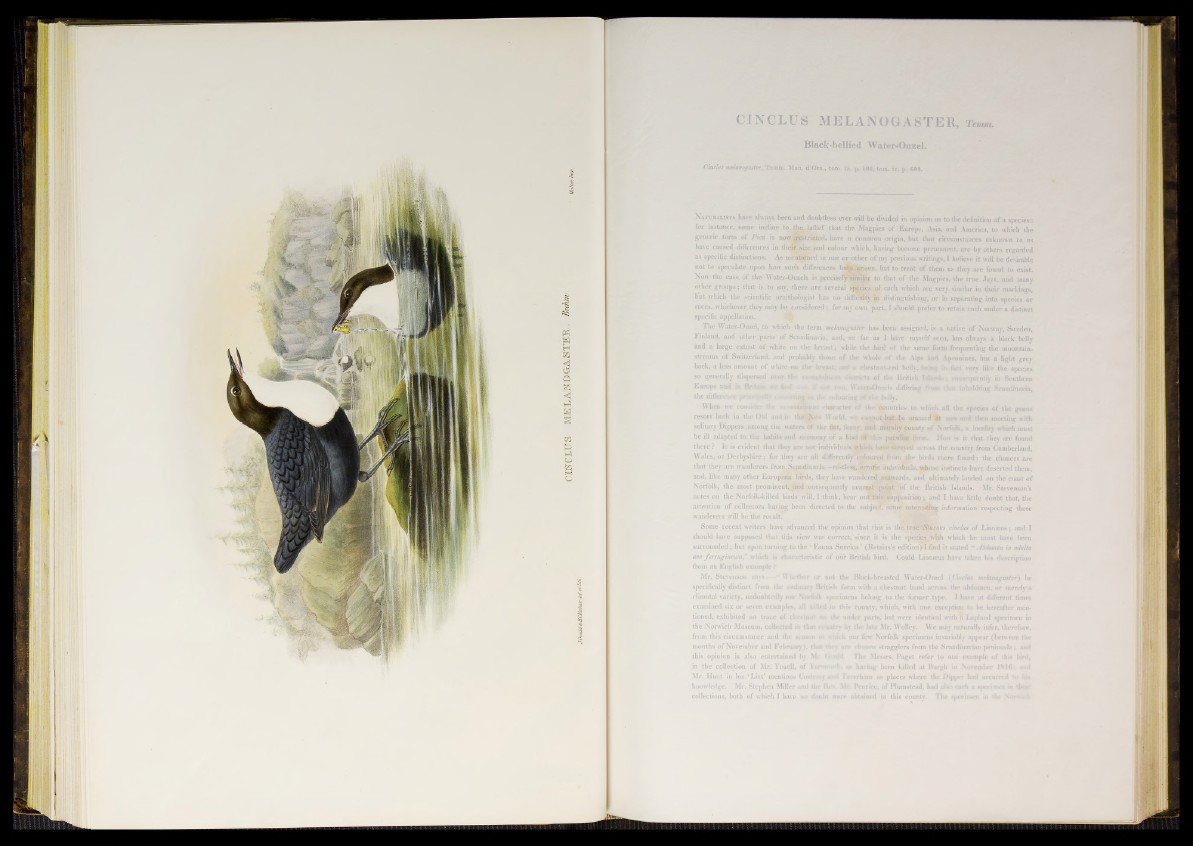
CIN'CLTJS M E L A N O G A S T E R , Brekrru.
Cinclus melanogaster, Teiani. Man. d’Orn., tom. iii. p. 106, tom. iv\ p. 609.
Temiti.
N a tu r a l ist s have always been and doubtless ever will be divided in opinion as to the definition o f a species :
for instance, some incline toy foe belief that the Magpies o f Europe, Asia, and America, to which the
generic term of Pica is now ^estrictcd, have a common origin, but that circumstances unknown to us
have caused differences in their size and colour which, having become permanent, are by others regarded
as specific distinctions. As mentioned iu one or other of ray previous writings, I believe it will be desirable
not to speculate upon how such differences haye afcisen, but to treat o f them as they are found to exist.
Now the case o f the Water-Ouzels is preciself Similar to that of the Magpies, the true Jays, and many
other groups ; that is to say, there are several species o f each which are very similar iu their markings,
but which the scientific ornithologist has no difficulty jn distinguishing, or in separating into species or
races, whichever they may be considered : for my own part, I should prefer to retain each under a distinct
specific appellation.
The Water-Ouzel, to which the term melanogaster has been assigned,’ is a native of Norway, Sweden,
Finland, and other parts o f Scandinavia, and, so far as I bave myself seen, has always a black belly
and a large extent o f white on the breast ; while the bird of the same form frequenting the inountainof
streams o f Switzerland, and probably tli
back, a less amount of white on the breast, and .
so generally dispersed over the tniMtttwtoGOR 4 h
Europe and in Britain kitd «»e,
the difference prinnpffo j tsnafofofoie foe colour in
When we consider thv mouufcifityHX <-buracter
resort both in the OKI and in the New World, «
solitary Dippers among the waters o f the fiat, few
be ill adapted to the habits and economy o f a bird o f this
there ? I t is evident that they are not individuals v h icb b;v^
Wales, or Derbyshire; for they are all differently coloured
the whole o f the Alps and .Apennines, has a light grey
a chestnut-red belly, befog in tact very like the species
i districts o f the British I 4 a » 4 ; consequently in Southern
Water-Ouzels differing fo m that inhabiting Scandinavia,
raring u f foe belly.
t ier of the countries to which all the species o f the genus
sot but be amazed at now and then meeting with
1 marshy county o f Norfolk, a locality which must
(»S' pacttiiar form. How is it that they are found
Irave Sftrayed across the country from Cumberland,
inn foe birds there found: thè chances are
that they are wanderers from Scandinavia—restless, erratic individuals, whose instincts have deserted them,
and, like many other European birds, they have wandered seawards, and ultimately landed on the coast of
Norfolk, the most prominent, and consequently nearest point of the British Islands. Mr. Stevenson’s
notes on the Norfolk-killed birds will, I thiuk, bear ourfois ^Opposition ; and I have little doubt that, the
attentiou o f collectors having been directed to the subject, some interesting information respecting these
wanderers will be the result..
Some recent writers have advanced the opinion that this is the trde^Sturnus citiclus of Linnseus ; and I
should have supposed that this view was correct, since it is the species with which he must have been
surrounded; but upon turning to the ‘ Fauna Suecica ’ (Retzius’s edition)'! find it stated “ Abdomen in adulta
ave ferrugineum," which is characteristic of our British bird. Could Linnseus hare taken his description
from an English example ?
Mr. Stevenson says :—“ Whether or not the Black-breasted Water-Ouzel ( Cinclus melanogaster) be
specifically distinct from the ordinary British form with a chestnut band across the abdomen, or merely a
specimens belong to the former type. I have a t different times
I in this county, which, with one exception to be hereafter ineni
the under parts, but were identical with a Lapland specimen in
an try by the late Mr. Wolley. We may naturally infer, therefore,
a inch our few Norfolk specimens invariably appear (between the
foey are chance stragglers from the Scandinavian peninsula ; and
'•"id. The Messrs. Paget refer to one example of this bird,
»»nth. as having been killed at Burgh in November 1816: and
ami faverham as places where the Dipper bad occurred to hi*
lev. Mr. Pernice, of Plumstead, had also each a speriiuea in «bctr
k were obtained in this county. The specimen in the Norwich
climatal variety, undoubtedly i
examined six or seven examples, all ktttc
tioned, exhibited no trace of chestnut c
the Norwich Museum, collected in that o
from this circumstance and the season a
months o f November and Februarv), that
this opinion is also entertained by Mr.
in the collection o f Mr. Youell, o f Van
Mr. Hunt in his ' List’ mentions Coates»
knowledge. Mr. Stephen Miller and the
collections, both o f which I have no dots